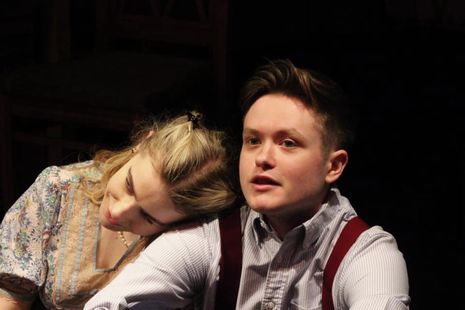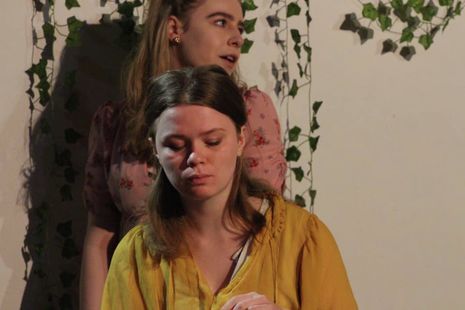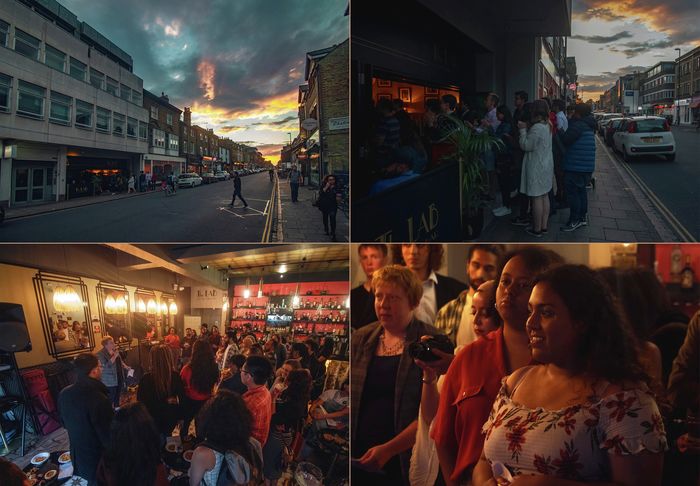Lovesong is a warm and poignant tear-jerker
Bethan Holloway-Strong finds a delicate beauty in this naturalistic production

A moving portrait of love and companionship, Abi Morgan’s Lovesong shows young couple William and Margaret alongside their seventy-year-old selves, exploring time and memory and how these forces affect their relationship. This is a beautifully written play directed just as beautifully by Ella Gold and brought to glorious life by the four actors. Although lacking some stylistic consistency, this is an accomplished production that does not leave a dry eye in the house.
Immediately upon entering the Corpus Playroom, the audience is enveloped by Amber Hyams’ incredible set design. Curling vines hang down from the ceiling, a wooden tree grows in one corner, and the scene is brought together by a warm-toned bedspread and kitchen set. Isobel Wood’s lighting design perfectly complements the set, and it is particularly effective in creating a separation between the outside and inside spaces on the relatively small Corpus stage.
Dixie McDevitt (Maggie) and Tom Hilton (Billy), who play the seventy-year-old couple, do remarkably well in portraying the characters’ age without affectation. Staying away from the overdone grey hair and cane, Hilton’s hunched-over physicality immediately places the audience in the right space and time. McDevitt also does well with this, but some deterioration in her mobility may have been more effective in this production. Maria Telnikoff’s movement direction certainly achieves great results, but it has the potential to be exceptional with a greater consideration of character and time.

In terms of acting, McDevitt is the perfect foil to Hilton’s cynical Billy. She delivers Maggie’s unfailing optimism without straying into cliché. Hilton portrays the perfect caring husband, driven by love and companionship for his aging wife. Both actors also do very well in fitting in with their younger counterparts, William (Charlie Morrell-Brown) and Margaret (Lydia Clay-White). The relationship between the two sets of characters is very believable, and the audience can see Morrell-Brown’s temper transform into Hilton’s stubbornness, and Clay-White’s frenetic energy mellow into McDevitt’s positivity. The surreal interactions between the two timeframes were played to perfection and brought a new level of quality to the production.
This is an accomplished production that does not leave a dry eye in the house.
The real value of this production lies in its naturalism. Morrell-Brown and Clay-White are particularly skilled in this area: the delivery of their fights as a couple is especially believable. There are some monologues in the play, but these do not feel as naturalistic. It is difficult to present a believable monologue, but the stylistic difference between the monologues and the rest of the play feels jarring. Since the rest of the production works so well, the monologues would benefit from a less stylised delivery.

There were some technical difficulties on opening night, so it was hard to judge the efficacy of the use of projection in the production. With the naturalistic feel of the play, this visual element may have taken away from its poignancy, but it ultimately cannot be judged.
Cameron White’s sound design worked well, but it could have benefitted from being more simple. Some moments felt overshadowed by transitional music and could have been more impactful if left in silence. The choice of songs, however, was impeccable and perfectly complemented the mood of each scene.
This production is incredibly moving, thanks to the work of the actors and the beautiful production design. The lighting, set, and sound design all work together to create a warm feeling of domesticity that allows the actors to shine. Although it falls down in some isolated moments, it is a poignant theatrical experience that is definitely worth seeing.
 Features / Should I stay or should I go? Cambridge students and alumni reflect on how their memories stay with them15 December 2025
Features / Should I stay or should I go? Cambridge students and alumni reflect on how their memories stay with them15 December 2025 News / Cambridge study finds students learn better with notes than AI13 December 2025
News / Cambridge study finds students learn better with notes than AI13 December 2025 News / Dons warn PM about Vet School closure16 December 2025
News / Dons warn PM about Vet School closure16 December 2025 News / News In Brief: Michaelmas marriages, monogamous mammals, and messaging manipulation15 December 2025
News / News In Brief: Michaelmas marriages, monogamous mammals, and messaging manipulation15 December 2025 Comment / The magic of an eight-week term15 December 2025
Comment / The magic of an eight-week term15 December 2025









